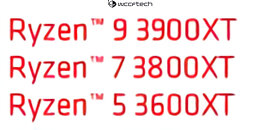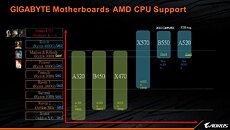Saturday, May 23rd 2020

AMD "Matisse Refresh" Processor SKUs Include 3900XT, 3800XT, and 3600XT
Rumors of AMD refreshing its 3rd generation Ryzen desktop processor family are growing louder. On Friday (22/05), reports of the "Matisse Refresh" processor family surfaced, with talk of "Ryzen 7 3850X" and "Ryzen 7 3750X" processors headed for a June 2020 announcement followed by July availability. Turns out AMD has a different naming scheme in mind, targeted at wooing gamers. The company is reportedly bringing its "XT" brand extension over from its Radeon graphics card family over to the Ryzen line.
There are three SKUs AMD is developing, the Ryzen 9 3900XT, the Ryzen 7 3800XT, and the Ryzen 5 3600 XT. All three are likely to retain core counts of the SKUs they are displacing from current price points - with the 3900XT likely being a 12-core/24-thread part; the 3800XT an 8-core/16-thread part, and the 3600XT a 6-core/12-thread part. AMD is likely to give the three a major clock speed increase to shore up gaming performance. It won't surprise us if AMD tinkers with boost algorithms, either. GIGABYTE has already referenced "Matisse Refresh" in its motherboard product roadmaps, which adds plenty of credibilty to this rumor. With "Zen 3" based 4th gen Ryzen processors unlikely to relieve the embattled 3900X, 3800X, and 3600X in the wake of Intel's 10th gen Core "Comet Lake" launch until Q4-2020, it makes sense for AMD to plan a product stack refresh to bolster its competitiveness. AMD is reportedly planning a June 16 product announcement, followed by July 7 availability.
Sources:
WCCFTech, via VideoCardz
There are three SKUs AMD is developing, the Ryzen 9 3900XT, the Ryzen 7 3800XT, and the Ryzen 5 3600 XT. All three are likely to retain core counts of the SKUs they are displacing from current price points - with the 3900XT likely being a 12-core/24-thread part; the 3800XT an 8-core/16-thread part, and the 3600XT a 6-core/12-thread part. AMD is likely to give the three a major clock speed increase to shore up gaming performance. It won't surprise us if AMD tinkers with boost algorithms, either. GIGABYTE has already referenced "Matisse Refresh" in its motherboard product roadmaps, which adds plenty of credibilty to this rumor. With "Zen 3" based 4th gen Ryzen processors unlikely to relieve the embattled 3900X, 3800X, and 3600X in the wake of Intel's 10th gen Core "Comet Lake" launch until Q4-2020, it makes sense for AMD to plan a product stack refresh to bolster its competitiveness. AMD is reportedly planning a June 16 product announcement, followed by July 7 availability.


120 Comments on AMD "Matisse Refresh" Processor SKUs Include 3900XT, 3800XT, and 3600XT
So this would mean the 4900 would need to match that boost, which is quite a lofty target if it includes +10% IPC on top. Otherwise it would be very strange releasing 4000 CPUs with lower boost clocks than these 3 months later.
But it does makes me wonder if Zen 3 is on track or not.
XT is a declaration of intent. This is a gaming-performance focused refresh.
200mhz above their current prospective model numbers would even be good, but there's no way they have 700mhz in them whatsoever based on every single review of zen2
- base clock raised by 200 - 300 Mhz.
- boost clock at 300 - 500 Mhz. 700Mhz would be pipe dream.
- toying with CCX'es inside their CCD.
- TDP will be listed 1 tier above, eg 95 to 105W and 105 to 125W.
- no "new tech" will be implemented as these build on same node and same architecture.
But hey, if price is right, why not. I need CPU for my upcoming B550 :p
On the other hand, why not bring out new chips now that they have the numbers to bin like this? Who in their right mind would think this was a bad sign about something?
It's all about the media cycles. Now AMD will have a new "3800XT Review" on the front page of most tech sites, and it'll have the bonus of comparing Zen 2 with about a year of small, cumulative optimizations plus even higher clocks vs Intel's new 10th gen, instead of using number for relatively 'unoptimized' first run Zen 2 parts.
But with substantial gains in transistor density we should expect decent architectural advancements, not just in terms of core count and caches, but also more superscalar scaling, SIMD and ISA improvements.
Not so sure the XT branding is that helpful though. CPU looks very similar to GPU model now.
In about 2 months i'll have spare cash to upgrade things, and i like seeing all these extra choices